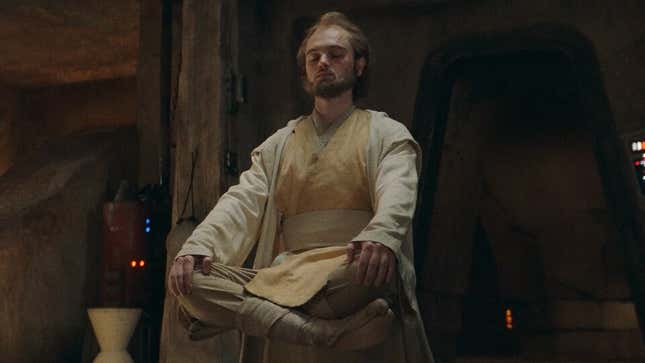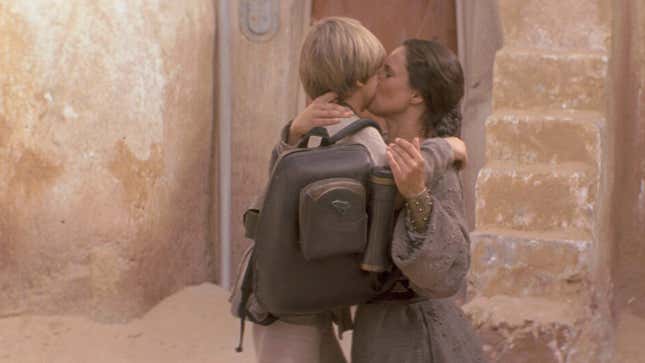Disney Plus’ latest Star Wars series, The Acolyte, was always going to court controversy. The Star Wars fandom has an infamously vocal minority who are, for lack of a better term, bigots, and Lucasfilm had already promised to stand up to them ahead of the series’ launch. But after The Acolyte episode 3, an entirely different Star Wars controversy has cropped up, reigniting a tired debate waged in internet forums and on social media: Are the Jedi good guys or bad guys?
Countless people (myself included) have weighed in on Star Wars’ lightsaber-wielding monks, their relationship with the Force, and their machinations. But the inability of some fans to notice nuance and their overreliance on binaries has once again brought us back here—the fact that it’s on the back of The Acolyte just makes this all the more tiring.

The events of The Acolyte episode 3
All of The Acolyte’s third episode takes place within a flashback: 16 years before the start of the series, a coven of witches are hiding out on a planet called Brendok after fleeing persecution by those who believed they were wielding the Force for evil. This is the first canonical sect of witches since the Nightsisters of Dathomir, who very much hem closer to the evil side of Force use, though the show goes to great lengths to ensure we don’t paint the Witches of Brendok with the same broad strokes (even having them chant a spell entirely in English because I’m sure another language would be “too scary”).
Much like the miracle of Anakin Skywalker’s conception (he had no father, and was created entirely by the will of the Force and carried by his mother, Shmi), the witches have two twin girls in their midst: Mae and Osha, who were “created” by their mother Aniseya and carried by her partner, Koril (also a woman, yay space lesbians!).

The witches know that a group of Jedi have landed on Brendok and are determined to keep the girls hidden from them, as it’s illegal to be training children in the Force (unless you’re a Jedi, of course). When the Jedi show up uninvited, the girls are discovered, and Andara (played by Carrie-Anne Moss) tells the witches that under Republic law, they have the right to test Force-sensitive children. Osha wants to go with the Jedi, as she yearns for a life off of Brendok, but Mae and the other witches are wary, and they plan for the girls to intentionally fail the Jedi test. Koril calls the Jedi “deranged monks.”
Osha refuses to lie, however, and passes the test. Lee Jung-jae’s Sol tells her that she’d have to leave her mother and sister behind and never see them again if she wants to join the Jedi, a decision he says he made at four years old (no one should be making such decisions at four years old, you are still occasionally shitting your pants at that age). But Osha decides to go with them, and in a fit of rage, Mae starts a fire in the witches’ temple. They all end up dying, including their mother, but it’s very clear that there’s a side to the story we aren’t hearing, and that this version of events doesn’t completely add up.
After the episode aired, social media was ablaze with people arguing over the Jedi’s morality, and if they do, indeed, kidnap kids and indoctrinate them into a cult. Staunch believers in the notion that the Jedi always have been and always will be The Good Guys raged against this idea—especially when presented through the lens of Black lesbian witches, god forbid—but as is the case with most internet debates, the truth is far more complex.
The Acolyte reminds us of the Jedi’s flaws
The Jedi are a complicated, flawed group of people whose allegiances and motivations have shifted dramatically from the High Republic era through the Clone Wars and beyond. The original Star Wars trilogy paints the Jedi as tragically extinct warriors of justice and peace, while the prequel trilogy shows the cracks that began to form amongst them after getting too deep in-bed with the government. The sequel trilogy promised a democratization of the Force, an understanding of it outside the rigid boundaries of the Jedi’s teachings, before somewhat tearing that down with the bizarre Rey Skywalker shit.

During the High Republic, the Jedi Order was in its golden age, working alongside (but separately from) the Galactic Republic. There was more fluidity in their teachings: they could become Wayseekers, or Jedi entirely independent from the Council; and the Barash Vow was instated, in which Jedi could choose to isolate themselves from society in order to become closer to the Force.
But the lack of proper channels for communication during that era led to the proliferation of whispers and rumors about a dark force growing in strength at the edges of the galaxy—and that kind of anxiety is precisely what can cause four mostly well-meaning Jedi to make an absolute mess of a tense situation. As Polygon’s Tasha Robinson writes about the events on Brendok:
None of this is a good look for the Jedi. The whole sequence, with its deliberate omissions and obfuscations, feeds directly into the questions fans have had about Jedi recruitment since the prequel movies started showing us more about the induction process. The baseline Jedi rules are remarkably similar to real-world cult tactics: Trainees are separated from their families and taught to disavow any personal connections, they’re forced to accept their teachers’ proscriptive ascetic values, and it’s made clear that any deviation or pushback against them is cause for expulsion from their replacement family. The Phantom Menace-era Jedi also refuse trainees as “too old” starting at least at age 9, which reads as a feeling that inductees should be young enough to be malleable, without any pesky emotional attachments or opinions of their own.
Though we don’t yet know what causes the fall of the High Republic, we can glean some understanding of how we ended up getting to the Clone Wars-era Jedi Council after watching this latest episode of The Acolyte. By the time we meet Anakin Skywalker, the Jedi have clearly become too draconian in their beliefs, too openly fearful of the Dark side, and too blind in their allegiance to the Republic—so much so that they can’t even sense Emperor Palpatine is in their midst.

They take a powerful child away from his slave mother, demand he renege all attachments, and command he never create any new ones—save for those in the Order, of course. Then, between Palpatine’s antics, the burgeoning war with the Trade Federation, and the Jedi’s refusal to give Anakin an inch, the poor boy is squeezed in a stress vice until he cracks. And thus goes the tragedy of Anakin Skywalker, the Chosen One, whose gift was squandered by the very people meant to nurture it.
We have been told that the Jedi have flaws since the beginning of Star Wars as a franchise. Luke Skywalker’s refusal to cut down his father was motivated by attachment, by familial love, by loss, all things the Jedi are fundamentally against. But ever since Rian Johnson’s The Last Jedi dared to ask if, perhaps, the Force could be wielded by anyone, be they a street urchin on Canto Bight or a junk collector on Jakku, it seems Star Wars fans have struggled to realize that the Jedi aren’t inherently the lawful good people in this universe. They, like anyone else, are flawed beings who can be manipulated or used for questionable causes.
Flexing the boundaries of what the Force can be, of how people who are Force-sensitive can be trained, speaks to a more broad spiritual theme that Lucas and his knights of the Star Wars roundtable have been trying to tease out for decades. You don’t need to be indoctrinated into a cult to be religious, or spiritual, or gifted, and you most certainly don’t need to be trained by the Jedi Council in order to help restore peace, justice, and democracy to the galaxy. It seems The Acolyte is determined to remind us of that.
.


